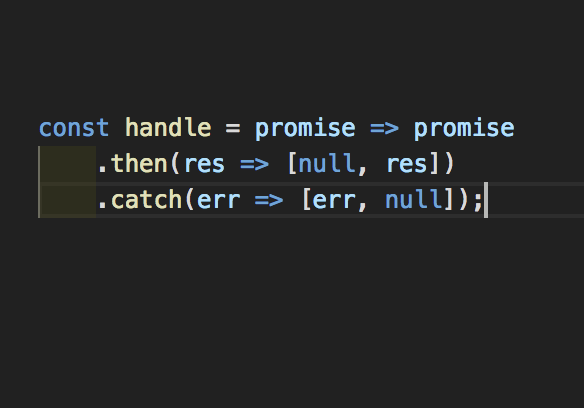By Sam Williams
Every developer has their favourite patterns, functions or bits of code. This is mine and I use it every day.
What is it?
This little function takes a promise and returns an array of the error and the result of the promise. It’s super simple but can be used for some amazing things.
What can it do?
Clean error handling with async / await
This is the main reason that I use this method every day. At work, we are trying to write all code using async / await syntax for future readability and maintainability. The problem is that awaiting a promise doesn’t tell you if the promise has succeeded or failed.
let unimportantPromiseTask = () => {
Math.random() > 0.5 ?
Promise.reject('random fail') :
Promise.resolve('random pass');
};
let data = await unimportantPromiseTask();
If this promise passes then data = ‘random pass', but if it fails then there is an unhandled promise rejection and data is never assigned a value. This may not be what you would expect to happen when reading through the code.
Passing the promise to this handle function returns a very explicit result which anyone can easily understand when reading it.
let [err, res] = await handle(unimportantPromiseTask());
You can then do what you want with the error and result. Here is a common pattern that we often use next:
if (err
(res && !res.data)) {
// error handling
return {err: 'there was an error’}
}
// continue with successful response
The main reason we use this instead of wrapping the awaited promise in a try / catch block is that we find it easier to read.
Stop unhandled promise rejections
This function can be used to handle promises (hence the name). Because the function chains .catch onto the promise, if it fails the error is caught. This means if there is a promise that you call and don’t care whether it passes or fails, just pass it into handle!
unimportantPromiseTask(); // 50% chance of erroring
handle(unimportantPromiseTask()); // never errors
Without passing the promise into the handle function, there is going to be a chance that it fails. This is increasingly important as future versions of Node are going to terminate the process when an unhandled promise rejection is encountered.
The other ways to handle promise rejections are to wrap the function in a try catch, or just to chain a .catch onto the promise. Whilst these are both very valid, using handle where we can makes our code more consistent.
Thanks for reading this quick post on my favourite line of code. If you’ve got a favourite line of code, let me know in the comments what it is and why!
